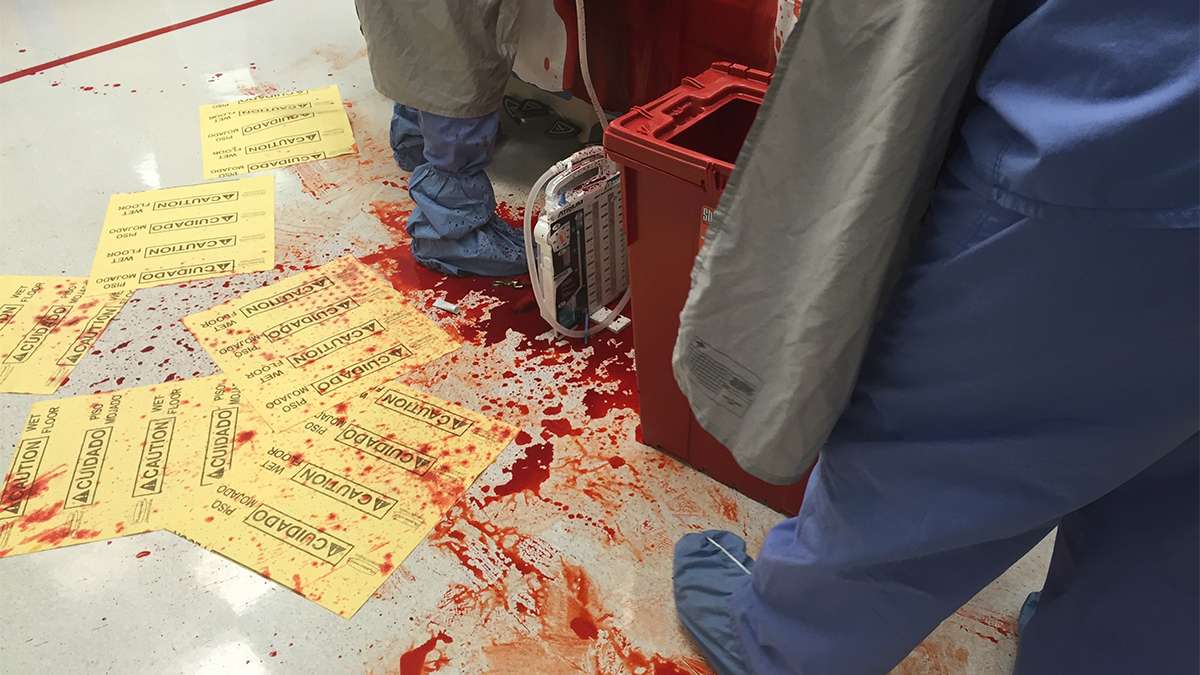For at-risk students, a grim look at the results of gun violence
ListenA program at a Delaware hospital aims to show the gruesome impact of violence, and save lives.
Gun violence is increasingly seen as a public health problem – an issue that could benefit from aggressive prevention and education campaigns. Many physicians and nurses are on board with this – because they encounter the victims of gun violence so frequently in their daily work.
“We see them almost every day, I was just on call yesterday and I had two; one survived and one did not,” said trauma surgeon Sandra Medinilla. She works at Christiana Care Health System’s Christiana Hospital in Newark – where most of the gunshot victims from Wilmington are treated.
Wilmington, Delaware is among the most violent small cities in the country. Gun violence has claimed 11 lives so far this year, and 56 people were injured in shootings. Medinilla and other doctors and nurses at this facility are volunteering their time for an unusual program to prevent more violence.
The name of the program is YOLO — you only live once — which of course has become a social media meme, and excuse to do all kinds of idiotic things. But here, YOLO takes on its more literal meaning – and emphasizes the importance of making good choices.
High school students from some of Wilmington’s poorest and most violent neighborhoods come to the hospital and first gather in a classroom for what looks like a regular lecture class. Many have an annoyed expression on their face, as in “why am I here?”
But that begins to change as Chaz Molins, violence prevention coordinator for the Christiana Trauma Program, tells them about Brandon Brinkley. Brinkley got in trouble as a teen, went to prison, but then started to get his life back on track. He wanted to become a barber.
Molins accentuates the story with pictures of Brandon, smiling, or hugging his sister.
Then the story takes a dark turn. The kids are now leaning in to listen. “Do you know what GSW stands for” asks Molins. Every student in the audience nods. “Gunshot wound” several students call out. Molins nods. “Nice,” he says at first, acknowledging that they got the answer right. Then he follows up with “I’m sorry that you know that.”
In December of 2008, after a night out with friends, Brandon Brinkley was shot three times – in the head, neck and back, and then treated at the trauma center at Christiana Hospital. He was 25.
At this point, the lecture is interrupted. A trauma code is called over the hospital’s speaker system. The students are quickly ushered into the adjacent room, an operating room setting. It’s usually used to train medical professionals. A group of trauma doctors and nurses rush in and suit up for surgery. All of them work in trauma care, and volunteer their time to reenact this case for the students. They are focused and serious, and it’s easy to forget that this is a simulation.
A very realistic looking manikin representing Brandon Brinkley is wheeled in. The team begins frantic efforts to save his life. They intubate the manikin, and push on his chest. The manikin bleeds and the OR floor is covered in blood. Soaked bloody rags are all over the floor. Monitors are beeping.
The team is unable to revive the patient, the monitors emit a long uninterrupted beep. Flatline. The patient is pronounced dead.
The operating room goes dark, and the students sit in stunned silence.
Brandon Brinkley’s mom has been observing the simulation in the back the entire time, crying quietly. She often attends these programs, even though it’s very painful for her. “That’s the hardest part, because that’s what happened, factually, and it brings tears, every time,” she said. “But I do work in a mortuary so we see victims all of the time.”
Since her son’s death, Robin Brinkley White has been putting a lot of her time and effort into violence prevention.
The hospital staff members who give their time to re-enact this awful moment in the ER are somber – as if they really just lost a patient. Brian Perry is an emergency medicine resident at Christiana, he says he participates because gun violence hits very close to home. He grew up in a violent neighborhood in Wilmington himself, and credits his mother’s constant vigilance for keeping him on a path to med school.
“I have had a lot of close family members and friends affected by gun violence, and it’s a cycle that perpetuates itself,” he said.
Nurse Amy Whalen says as a mom, she feels like she has to do something to help stop the senseless violence.
“I feel for Mrs. Brinkley – and when these kids come in and they are dead, they are dead, that’s the end of it, but their mothers have to go on. And they have to bury their children. It’s very difficult to see that pain in a mother’s eyes, and I don’t want to have to continue to see that in a mother’s eyes.”
Afterwards, the students discuss what they have seen — and they talk about making good choices, staying out of trouble as much as possible.High school senior Calvin Copeland is 18, he says he has a lot of friends who have been affected by gun violence. He maintains a cool demeanor, but describes the program as an eye opener:
“Basically, watch who you’re around, take your time, don’t be in a bad situation, or you’ll end up at a trauma center.”
The million dollar question with programs like these is always – does it really work. Or will Calvin and his friends go home, and forget about today?
Social worker Chaz Molins says the program just received a big grant to update the evaluation process, and to better measure impact. But he says what’s most important is to change the thinking, and the culture, that perpetuates gun violence. For example, he says a lot of the kids he interacts with don’t think they’ll live past 21 years of age.
We had a gunshot victim here. He was 24 years old. And he was telling me, I’m an old head. I said – dude, you are 24. He said all the kids I came up with, they are all dead.
So, the end game is not just to scare kids with the gruesome reality of what happens in a trauma bay – but to inspire them to envision and pursue a future – a life that doesn’t include gun violence
And that vision is what keeps Robin Brinkley White coming back. “Even if you get one, if you get two… we want them all, but if we get a few of them, it will help.”
Her son’s murder has not been solved yet.
This piece was updated on June 7, 2016.
WHYY is your source for fact-based, in-depth journalism and information. As a nonprofit organization, we rely on financial support from readers like you. Please give today.





